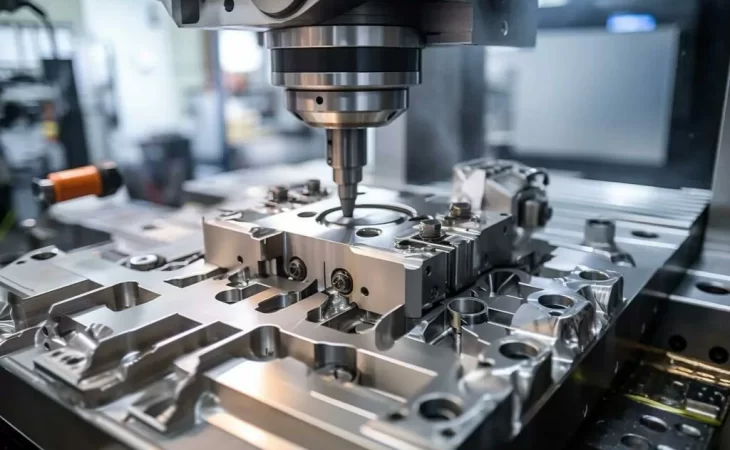Metal fabrication shops play a significant role in producing a wide range of metal components and structures. Manufacturers employ processes like CNC machining, sheet metal fabrication, metal casting, and 3D printing to create their desired metal parts. These processes allow for turning raw metal materials into precise, functional parts for the automotive, aerospace, and construction industries.
This article explores the operations of various metal fabrication shops.
Metal fabrications is the process of creating metal structures and components through processes like cutting, bending, and assembling. This manufacturing process may utilize welding, casting, machining, and forming techniques, which are used to shape metals into specific designs and products.
Depending on the specific process, the raw materials in metal fabrication are usually sheet metal, pipes, bars, or a solid block, as in machining. The raw materials are manipulated using controlled techniques and operations to suit the manufacturing process until the intended shape and structure are formed.
Metal fabrication processes are essential in producing various items, from small parts to large structures, used in automotive, aerospace, construction, and other manufacturing industries. Different machine shops specialize in one or more metal fabrication techniques, providing custom solutions and mass-produced parts according to suit client specifications.
As mentioned earlier, metal fabrication shops often employ processes and technologies like CNC machining, sheet metal fabrication, metal casting, and even 3D printing. Each method presents unique features and applications that suit various projects.
Below, we explore the standard techniques used by metal fabrication shops.
Contents
CNC Machining
CNC (Computer Numerical Control) machining is a precision manufacturing process. The technique involves using computer programs and codes to control cutting tools to remove material from a workpiece. Because of this feature, the operation requires little human interference, particularly after programming and configuring the device.
Metal fabrication shops utilize various CNC machining processes, including milling, turning, and drilling. Each method possesses its peculiarities, but they all suit high-precision fabrication, allowing manufacturers and OEMs to create the desired shape and structures regardless of design complexities.
Quality
CNC machining offers superior quality and precision, with tolerances of up to 0.01m, and even more, especially when using multi-axis CNC. Since the operation is computer-controlled, the machine can operate independently, allowing for consistent fabrications without compromising quality, even when creating high-precision parts. Compared to other methods like metal casting, CNC machining can achieve finer details and smoother finishes, particularly on intricate parts.
Lead Time
The lead time for any metal fabrication process, including CNC machining, may vary depending on the part’s complexity and production volume. However, this technique generally offers CNC machine shops faster turnaround times, particularly for bulk volume production, as the device can operate 24/7. The setup time is relatively short, and once programmed, the machines can operate autonomously, speeding up the production process.
Cost
The cost of CNC machining may be higher than other methods, especially for small volumes and prototypes. However, it becomes cost-effective for bulk and complex parts requiring high precision. The initial investment in CNC machines and tooling may be substantial, but the reduced labor costs and automation can offset this in the long run.
Sheet Metal Fabrication
Sheet metal fabrication encompasses a series of processes, including cutting, bending, and assembling flat metal sheets into desired shapes and structures. This process is distinctive because it involves creating parts with metal sheets.
Metal fabrication shops may utilize techniques like laser cutting, punching, bending, and welding to make parts and components from thin metal sheets. These techniques are widely used in the automotive, aerospace, and construction industries due to their versatility and efficiency in producing simple and complex shapes.
Quality
Like CNC machining, sheet metal fabrication offers good quality and precision. However, it generally doesn’t achieve the ultra-high tolerances possible with CNC machining. The quality of sheet metal fabrication may depend on the process adopted and the skill of the fabrication shop. In addition, the process particularly suits creating durable, lightweight components with a uniform thickness, making it suitable for enclosures, brackets, and panels.
Lead Time
The lead time for sheet metal fabrication may be relatively short, particularly for regular parts with simple geometries. This process quickly turns raw materials into finished products, especially when automated equipment like CNC laser cutters and press brakes is used. Compared to metal casting, sheet metal fabrication typically offers faster turnaround times, especially for low—to medium-volume production.
Cost
Sheet metal fabrication is generally cost-effective, especially for medium to high-volume production runs. Like all metal fabrication techniques, manufacturing costs are influenced by the complexity of the design, the type of metal used, and the precision required. The pricing for sheet metal fabrication is comparable to that of CNC machining. However, it may be more cost-efficient as the volume increases, thanks to lower material waste and quicker processing times.
Metal Casting
Metal casting is a manufacturing process that involves heating the metal material at high temperatures into the molten state. The liquefied metal is then poured into a pre-made mold cavity under high pressure, where it cools and solidifies into the resulting structure.
This versatile technique allows fabrication shops to produce parts using complex geometries. Metal casting involves several types of metal casting processes, including:
- Sand Casting: It uses a sand mold, often for large parts or short production runs. It’s cost-effective but typically results in a rough surface finish.
- Die Casting: This process involves forcing molten metal into a mold cavity under high pressure. It is suitable for high-volume production and provides a smooth finish with good dimensional accuracy.
- Permanent Mold Casting: It uses a reusable metal mold, providing a good surface finish and dimensional accuracy. It is often used for medium-volume production runs.
- Vacuum Casting: As the name suggests, this technique involves molding the molten metal in a vacuum devoid of air. This feature allows it to create parts devoid of the standard metal casting defect—gas porosity.
Quality
The quality of metal castings may vary based on the casting process used. Die casting and investment casting typically offer high-quality finishes and good dimensional accuracy, comparable to CNC machining for certain parts. However, sand casting may result in rougher surfaces and less precision. Metal casting allows for the creation complex and intricate shapes, including hollow sections, which might be challenging for other metal fabrication processes.
Lead Time
The lead time for metal casting significantly depends on the mold’s complexity and the casting process. Sand casting generally has a shorter setup time but might be slower in production than die casting, which, once set up, can rapidly produce large quantities. Investment casting has a more extended setup and production time due to the intricate process but excels in creating highly detailed parts. Metal casting typically has longer lead times than sheet metal fabrication and CNC machining due to the need for mold preparation and cooling times.
Cost
Compared to the other processes discussed in this article, metal casting is the most cost-effective, considering it does require less sophisticated tooling or machines. However, the choice of casting process, material, and production volume may influence the cost of metal casting.
Die casting and permanent mold casting require a significant upfront investment in molds and equipment. On the other hand, sand casting and investment casting can be more cost-effective for low—to medium-volume parts or parts with intricate details that would be expensive to machine. Another factor is material wastage, which is generally lower, potentially reducing overall material costs.
3D Printing
3D printing, or additive manufacturing, is a process that creates three-dimensional objects by adding the material layer by layer material according to a digital model. While many metal fabrication shops tend to use 3D printing to create plastic parts, the process suits manufacturing metal components.
In this case, the technique typically involves metal powder or filament fused layer by layer using methods such as selective laser melting (SLM), electron beam melting (EBM), or direct metal laser sintering (DMLS). 3D printing is highly flexible and can produce complex, intricate parts that are difficult to manufacture using traditional methods.
Quality
3D printing offers excellent quality for producing complex geometries and internal structures that are challenging for CNC machining and metal casting. The layer-by-layer construction allows for high precision and intricate detail, though the surface finish may sometimes require post-processing to achieve the desired smoothness. Unlike traditional methods, 3D printing can easily integrate complex features such as internal channels, which would be difficult or impossible to achieve otherwise.
Lead Time
The lead time for 3D printing can be relatively short, especially for prototypes or low-volume production. However, for large-scale production, the lead time for 3D printing is higher than that of other processes, as the machine singly creates individual components. Therefore, 3D printing is preferred for rapid prototyping and custom metal fabricators near me.
Cost
The cost of 3D printing depends on material choice, part complexity, and production volume. While the initial costs for equipment and tooling can be high, 3D printing is known for its cost-effectiveness for low to medium volumes. Parts can go from design to production quickly, further reinforcing the use of 3D printing for rapid prototyping and iterative design processes.
Metal fabrication shops often use 3D printing to produce complex parts or custom components, especially when traditional manufacturing requires expensive tooling. However, more conventional methods like die casting or CNC machining tend to become more cost-effective for high-volume production.
Conclusion
Metal fabrication shops have become partners for various companies, helping them create the required structures and components. These shops often utilize versatile processes to meet their clients’ industrial needs. However, they also serve custom fabrication projects for individuals and hobbyists.





